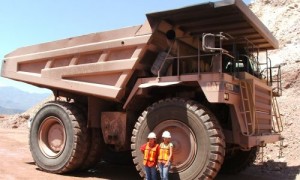By Cristina Avila-Zesatti
Global Press Institute
Once barred from mines by an ancient myth, women here make up an increasing percentage of the mining industry’s labor force as they try to support their families and fill in for men who have migrated north. The women of Mexico’s mines say they are convinced they can transform one of Mexico’s leading industries.
ZACATECAS, MEXICO – For the past three years, Cony Solís, 26, an industrial engineer, has been in charge of industrial security in the “Peñasquito” mine in Mazapil, a municipality of Zacatecas, a state in north-central Mexico with a long mining tradition. Solís is the only woman in an administrative position here working under Goldcorp, a Canadian gold producer operating Peñasquito, where some 13 million ounces of gold, silver and zinc lay hidden under an enormous desert.

The rest of the women work down in the mines.
“I work very closely with the women operators, the ones who are directly in the mine,” she says. “Our presence has been growing in this industry.”
Solís says that 10 percent of the 3,000 employees in this deposit are women.
“Perhaps it is not a lot, but it is something,” she says. “It is already an important number. The majority of us are very proud of what we do.”
Solís calls her work in the mine a “labor conquest” because it took so long for women to be accepted into this traditionally male industry. Solís’ mother also works in the mine, driving a truck – not just any truck, but one that weighs 2 tons and transports as much as 3 tons of cargo. Solís is, therefore, a second-generation woman in mining here.
A university graduate, Solís entered the mining industry by choice and as a professional receives schedule and salary perks. But the majority of the “mining women” in Mexico – and in other Latin American countries – entered the industry because they had few other options to support their families. Nevertheless, their presence in the industry has prompted several positive cultural changes and increased performance in some mines.
Mexico is one of the first countries in the region to welcome women into the mining industry. Many say that the female miners have improved the traditionally masculine industry, although their initial inclusion was more to fill the void left by men who migrated north to chase the “American dream” and greater income than to abolish gender discrimination. New technology and support systems have also aided women’s entry into the mining industry, but many say the job is still tough and that more must be done to turn back five centuries of exclusion.
An ancient myth invented centuries ago was what kept women out of the industry for so long. The myth suggested that the land would refuse to deliver its treasures to women, and if any woman dared to step into the depths of the mine, it would become jealous and close, causing cave-ins and hiding its wealth. Despite initial obstacles, the women of this mine say they are putting that myth to rest.
Mining is the third most important industry in Mexico, after petroleum and tourism, according to CAMIMEX and government sources. The number of employees in the mining industry has risen to almost 286,000, according to the Mexican Social Security Institute’s latest data, but not even industry officials know how many of these workers are women. What they do know, though, is that the number of mining women is undoubtedly increasing.
“We do not yet have a dependable statistic to know how many women at present are working in the mining industry of Mexico, although there are some businesses that staff up to 40 percent of their plants with female personnel, and this is without a doubt increasing,” says Sergio Almazán, director of the Mining Chamber of Mexico, CAMIMEX, an organization that lobbies for private mining companies.
In December 2010, the classified section of a local newspaper in Zacatecas showed a common announcement: “Seeking mine operator. Experience of 3 years in an open-faced mine and knowledge in operation in deposits of zinc, lead and copper; knowledge in processes of mining, geology and geotechnology.”
A want ad for a miner is not unusual in Zacatecas, a place long tied to the mining industry. Its founding during the Spanish conquest in the 16th century was thanks to its colossal internal wealth of copper, lead, zinc, gold and silver. In 2010, Mexico regained its place as the world’s top silver producer, according to CAMIMEX.
What made this ad published by Goldcorp unique was one small detail that just a few years ago would have been unthinkable in this centuries-old mining enclave. The ad did not specify the sex of the worker, breaking a five-century custom that barred women from the mining industry here.
“I always listened to the saying that if a woman entered, the mine closed, that it didn’t produce material or that it collapsed,” Solís says. “And, therefore, they should remain outside so that the precious metals don’t hide themselves from the eyes and the hands of the men and so that there weren’t accidents.”
But Almazán says this myth was based on sexism, not truth.
“I don’t know if Mexico is the only place where women miners exist, but when foreign people come here, they are very surprised to see this,” Solís says.
Almazán says Mexico is not the only place, but was one of the pioneers.
“We are not the only country that lives this phenomenon, but without a doubt Mexico has been the spearhead for the inclusion of the women in the mining industry,” Almazán says.
And to their credit, they have proved themselves.
“The inclusion of the women in the mining industry has been a total success – a true discovery for an industry that was 100 percent destined for men,” Almazán says.
He says their inclusion has even improved the industry.
“The work of the women has transformed labor relations, has made relations more respectful and harmonic,” he says. “Besides, the businesses have also discovered that the women are a lot more careful with the teams they handle, they are responsible, they do not fall into problems of alcoholism or of work absenteeism.”
Solís agrees.
“It is true that we are not as strong as the men, but I believe that we are more resistant to adverse conditions, such as the cold, or to spending many hours working,” she says.
Although Mexico has been one of the first countries to end the myth by opening mines to women, the change was made out of need rather than a drive for equality. In Mexico, as in many other parts of Latin America and the world, a lack of local male labor has become problematic here as many Mexican men continue to migrate to the United States in search of better wages and employment opportunities.
The first to bring in women to fill in the employment gaps here was Peñoles, a prominent mining company that hired 36 women to work alongside 210 men to work in Francisco I. Madero, the main zinc deposit in Latin America at the time. They turned to women to fill the void left by men, who had begun to migrate north.
Mexico has become one of the largest exporters of labor in the world in recent years, according to the National Population Council. The states of Zacatecas, Michoacán, Durango, Jalisco and Guanajuato top the list of places where increased migration have left male work forces lagging.
“There are many operators that have been in a lot of contact with this activity since they were girls because their parents or brothers were dedicated to the mine,” Solís says. “But in many cases, those men went to United States, and someone had to work and to maintain the family.”
Industry officials and employees also attribute women’s inclusion in mining to new technology and industrial and personal protection systems, which have modernized Mexican and transnational mining businesses.
Almazán says that mining jobs used to require extraordinary force and physical resistance, but that current technology has lessened physical requirements.
“Today, thanks to the machines and the professionalization, things are different,” he says. “Now, we find women working not only as workers, but also as laboratorians, geologists, engineers, researchers and even in executive positions. For the industry, this signifies having a new face, of more collaboration and solidarity.”
Many companies also make mining a more viable option for women by constructing “bedroom communities” or “dormitory towns” near the mining deposits, where workers stay for their 14 workdays of up to 15-hour shifts per day, followed by seven rest days. There, the mining women live together with their companions in common recreational areas before going to sleep in separate wings.
The “mining cities” also have basic services and precautionary measures in case of accidents, such as a medical clinic, a doctor, ambulances and fire trucks. Although foreign businesses created this model, Mexican companies have replicated it, not just in Zacatecas, but also in mines across Mexico, where women also used to be unwelcome.
But despite advances in technology and protection, the mining industry is still one of the most physically trying of the labor professions. Solís says mining also presents special challenges for mothers.
“In any case, the work is hard, and here there are many mothers who have to leave their children to come to cover their shifts,” says Solís, who, with an administrative position, is not subject to the same schedules as the operators.
Joana Moreno, 24, one of 16 women working in another gold deposit, “El Sauzal,” in Chihuahua, a state north of Zacatecas that also has a long mining tradition, says the masculine environment also takes some getting used to.
“You live in an environment of men and you have to adapt,” Moreno says. “For them, seeing us working here too is an incentive.”
Driving a large truck, Moreno says she is used to her new job and is happy here.
She and the other women here say they receive equal pay with their male counterparts. Moreno makes 9,000 pesos, $760 USD, a month as the operator of the trucks. Solís’ mother, who also operates a giant truck, earns 10,000 pesos, $840 USD, a month. As an administrator and a professional, Solís makes 14,000 pesos, $1,175 USD, a month. All are comparable wages to the men in the same mine.
Still, Moreno and Solís say some discrimination does still exist. Moreno says she hopes her supervisors will continue to confront situations of discrimination when they arise. But she says she knows hundreds of years of sexist tradition will not by forgotten in a few years.
Others recommend ensuring equality through unions and congresses, as other Latin American countries have done. But Mexico has been slow to adapt. In Chile, Bolivia and Peru, local unions now represent more than 2,000 women. Various countries also hold Women in Mining Congresses to discuss issues such as women’s dual jobs in mines and at home as mothers and housewives.
The story was originally published by Global Press Institute. (c) Global Press Institute 2012




